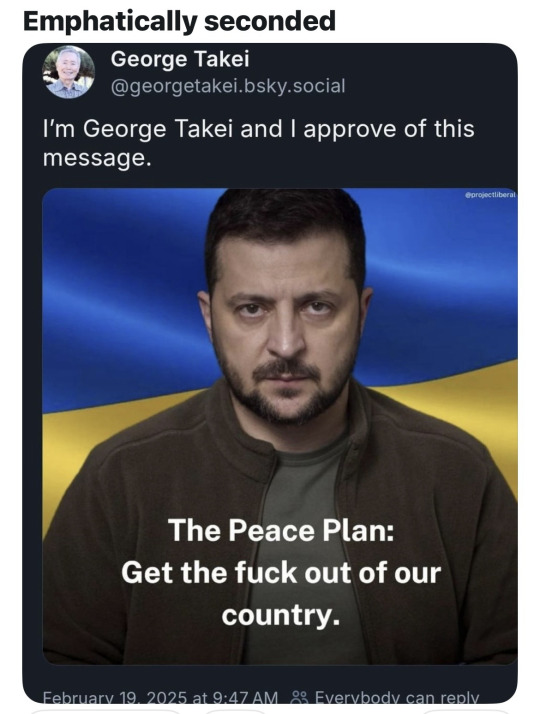#zelenszkij
Explore tagged Tumblr posts
Text
youtube
A Fridman bácsi mennyit tudja magyarázni, hogy egy amerikai egy ukránnal mért oroszul beszél, és mekkora baromságokat mond!
0 notes
Text
0 notes
Link
A háborúról egyeztetert Donald Trump és Volodimir Zelenszkij
0 notes
Text

#news#politics#usa news#us politics#donald trump#public news#world news#news update#breaking news#inauguration#fuck trump#fuck donald trump#project 2025#fuck facists#elon musk#fuck elon#fuck elon musk#fuck musk#fuck elon and trump#fuck elongated muskrat#doge#fuck doge#zelensky#volodimir zelenszkij#volodymyr zelenskyy#russia ukraine crisis#russia#russia ukraine war#russian invasion of ukraine#russian aggression
735 notes
·
View notes
Text

#zelensky#volodimir zelenszkij#zelenskyy#fuck donald trump#fuck jd vance#fuck us politics#meme#lol#donald trump#jd vance
434 notes
·
View notes
Text
How can anyone think he's interested in peace...



#zelinsky the actor#zelinsky#volodymyr zelenskyy#volodimir zelenszkij#ukraine is not our responsibility#usaid fraud#trump 47#God bless America
85 notes
·
View notes
Text

#slava ukraini#traitor trump#republican assholes#repulikans#crooked donald#resist#truth about ukraine#volodimir zelenszkij
86 notes
·
View notes
Text




#tiktok#prime minister justin trudeau#prime minister#president volodymyr zelensky#volodymyr zelenskyy#volodimir zelenszkij#Canada#ukraine#world leaders#peace summit#keir starmer
60 notes
·
View notes
Text
The real leader yesterday was Zelenskyy, him and him alone. Once again, Trump is making it clear that he plans to destroy America’s relationships with its allies. If you’re wondering why we support Ukraine alongside Europe, look at the Budapest Memorandum. The US, UK, and Russia agreed to this pact in 1994, providing security assurances to Ukraine in exchange for its denuclearization. Russia has been violating that agreement since 2014 when it annexed Crimea. Now, as Trump turns his back on Ukraine by suspending aid, it appears the US may go back on its promise too.
This isn’t just about Ukraine. It is about standing by our allies, keeping our word, and defending democracy against authoritarian aggression. Weakness is not supporting Ukraine. Weakness is abandoning them.
#SupportUkraine #StandWithAllies #BudapestMemorandum #DemocracyMatters

#ukraine#zelensky#jd vance#donald trump#ukranian#budapest#russia#putin#vladimir putin#volodimir zelenszkij#democrats#government#democracy#politics#fuck trump#united states#canada
27 notes
·
View notes
Text
"russia invaded Ukraine because they don't want nato on their borders" so they decided to take ukrainian territories so nato will be even closer to them?And what about Estonia, Finland, Poland?russia borders these countries that are in nato.Yet they attacking ukraine.Even more than that, putin said that he has no problems with Sweden and Finland in nato.And also who wanted to join nato??russia...right..
#ukraine#slava ukraini#fuck russia#fuck elon#fuck natzis#fuck republicans#fuck trump#republicans are garbage#republicans are domestic terrorists#republicans are evil#trump is the enemy of the people#trump is an idiot and so are his voters#trump is a criminal#elon is an idiot#liberals#democracy#politics#us politics#usa#fuck putin#fuck maga#maga is stupid#maga is a cult#kamala 2028#kamala 2024#kamala harris#trump is not my president#trump is a felon#volodimir zelenszkij#zelensky
26 notes
·
View notes
Text

30 notes
·
View notes
Link
Volodimir Zelenszkij ukrán államfő és Orbán Viktor magyar miniszterelnök megegyezett kedden Kijevben abban, hogy kidolgoznak egy olyan kétoldalú megállapodást, amely megoldja a két ország közötti vitás kérdéseket. Ezt Zelenszkij mondta el a magyar miniszterelnökkel közösen tartott sajtótájékoztatón.
0 notes
Text
I saw a video of a Ukranian man being forcefully dragged into a van to be forced into service, while begging to be let go because he has a family. Just pulled off the streets with no warning. Not even 5 minutes later, I saw another video of a Ukranian soldier, who was an adult man with Down Syndrome. JD Vance had and has every right to shame Volodymyr Zelensky for his military operations.
EDIT
I have found the videos and will provide the links below. While looking, I found another video of a man being forcefully taken off the streets. All videos are from @todayisamerica on Instagram
instagram
instagram
instagram
#make america great again#make america healthy again#make america safe again#trump 2024#donald trump#jd vance#president trump#pretty girls are conservative#donald j. trump#make america cowboy again#trump#trump administration#trump vance 2024#j d vance#vance#ukraine#zelensky#volodymyr zelenskyy#volodimir zelenszkij#united states#united states of america#usa#military#usmc#us marines#united states marines#marines#make america catholic again#Instagram
24 notes
·
View notes
Text
Viral photo from today's meeting of world leaders in Kyiv:

Ukrainian already making memes:

#news#public news#usa news#us politics#world news#donald trump#politics#news update#breaking news#inauguration#usaid#usa politics#usa#united states#america#boycott elon musk#boycott#resistance#protests#zelensky#volodimir zelenszkij#volodymyr zelenskyy#ukriane#russian aggression#fuck russia#russia ukraine war#russian invasion of ukraine#russia ukraine crisis#russia#ukraine
199 notes
·
View notes
Text

#meme#lol#us politics#fuck us politics#fuck trump#donald trump#fuck donald trump#zelenskyy#volodimir zelenszkij
199 notes
·
View notes